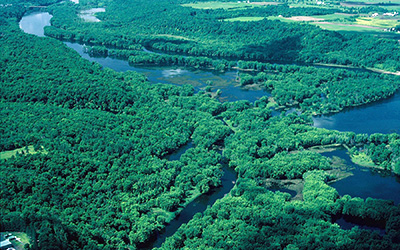Site Description
This IBA encompasses 28 miles of the St. Croix River from the cities of St. Croix Falls, Wisconsin and Taylors Falls, Minnesota south to Stillwater, Minnesota. It includes Interstate State Park, lands along the St. Croix National Scenic Riverway, Osceola Bedrock Glades State Natural Area, Farmington Bottoms State Natural Area, St. Croix Islands State Wildlife Area, and lands owned by Standing Cedars Conservancy. This IBA mirrors the Middle St. Croix IBA established on the Minnesota side. The northern section of the site is characterized by a steep river gorge and dry cliffs, some with no or sparse vegetation, others with ferns and lichens, and others with dry forest of cedar, basswood, white pine, and oaks. The southern part of the site contains excellent examples of floodplain forest of silver maple, green ash, hackberry, and American elm, along with emergent aquatics, forested seeps, and running sloughs and backwaters. The uplands here are forested with oak, basswood, aspen, birch, and white pine. There are scattered patches of dry prairie and savanna.
Ornithological Importance
This site is important for floodplain forest birds such as hooded merganser, red-shouldered hawk, bald eagle, Eastern wood-pewee, yellow-throated vireo, cerulean warbler, prothonotary warbler, and Louisiana waterthrush. Bank, cliff, and Northern rough-winged swallows all nest along the bluffs and American bitterns and marsh wrens breed in the marshes. There are several large great blue heron rookeries along this portion of the river, and bald eagles can be common in winter if enough areas of open water remain.

St. Croix River, photo by Mike Mossman